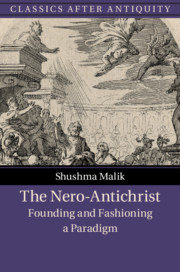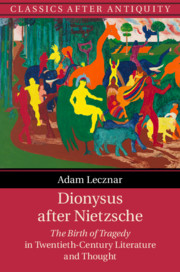Refine search
Actions for selected content:
60616 results in Classical studies (general)
Chapter 2 - Nero and the Bible
-
- Book:
- The Nero-Antichrist
- Published online:
- 27 March 2020
- Print publication:
- 16 April 2020, pp 16-78
-
- Chapter
- Export citation
Appendix - A List of Early-Christian References to the Nero-Antichrist
-
- Book:
- The Nero-Antichrist
- Published online:
- 27 March 2020
- Print publication:
- 16 April 2020, pp 197-197
-
- Chapter
- Export citation
Index
-
- Book:
- The Nero-Antichrist
- Published online:
- 27 March 2020
- Print publication:
- 16 April 2020, pp 224-228
-
- Chapter
- Export citation
Chapter 1 - Corybants, Satyrs and Bulls
-
- Book:
- Dionysus after Nietzsche
- Published online:
- 27 March 2020
- Print publication:
- 16 April 2020, pp 34-67
-
- Chapter
- Export citation
GREEK MILITARY TACTICS - (P.) Rance, (N.V.) Sekunda (edd.) Greek Taktika: Ancient Military Writing and its Heritage. Proceedings of the International Conference on Greek Taktika held at the University of Toruń, 7–11 April 2005. (Akanthina 13.) Pp. 308, b/w & colour ills. Gdańsk: Foundation for the Development of Gdańsk University, 2017. Paper, £40. ISBN: 978-83-7531-242-3.
-
- Journal:
- The Classical Review / Volume 70 / Issue 2 / October 2020
- Published online by Cambridge University Press:
- 08 April 2020, pp. 417-419
- Print publication:
- October 2020
-
- Article
- Export citation
(R.) Kaveney (trans.) Catullus. The Poems of Gaius Valerius Catullus: Some English Versions. Pp. iv + 153. Bristol: Sad Press, 2018. Paper, £8. ISBN: 978-1-912802-22-7.
-
- Journal:
- The Classical Review / Volume 70 / Issue 2 / October 2020
- Published online by Cambridge University Press:
- 08 April 2020, p. 532
- Print publication:
- October 2020
-
- Article
- Export citation
THE VARYING DEPICTION OF SOCRATES - (C.) Moore (ed.) Brill's Companion to the Reception of Socrates. (Brill's Companions to Classical Reception 18.) Pp. xviii + 1009, colour ills. Leiden and Boston: Brill, 2019. Cased, €219, US$253. ISBN: 978-90-04-39674-6.
-
- Journal:
- The Classical Review / Volume 70 / Issue 2 / October 2020
- Published online by Cambridge University Press:
- 08 April 2020, pp. 334-337
- Print publication:
- October 2020
-
- Article
- Export citation
LANGUAGE AND LITERATURE IN ANCIENT GREECE - (A.) Willi (ed.) Formes et fonctions des langues littéraires en Grèce ancienne. Avec la collaboration de Pascale Derron. (Entretiens sur l'Antiquité Classique 65.) Pp. x + 420, figs, colour pl. Geneva: Fondation Hardt, 2019. Cased, €65. ISBN: 978-2-600-00765-8.
-
- Journal:
- The Classical Review / Volume 70 / Issue 2 / October 2020
- Published online by Cambridge University Press:
- 08 April 2020, pp. 296-299
- Print publication:
- October 2020
-
- Article
- Export citation
THE ROMAN FRONTIER IN THE EAST - (T.B.) Mitford East of Asia Minor. Rome's Hidden Frontier. In two volumes. Pp. lii + 757, ills, maps, colour pls. Oxford: Oxford University Press, 2018. Cased, £247.50, US$370. ISBN: 978-0-19-814874-6 (vol. 1), 978-0-19-872516-9 (vol. 2), 978-0-19-872517-6 (set).
-
- Journal:
- The Classical Review / Volume 70 / Issue 2 / October 2020
- Published online by Cambridge University Press:
- 07 April 2020, pp. 464-466
- Print publication:
- October 2020
-
- Article
- Export citation
PLAGUES IN ROMAN LITERATURE - (H.H.) Gardner Pestilence and the Body Politic in Latin Literature. Pp. xii + 303, ills. Oxford: Oxford University Press, 2019. Cased, £65, US$90. ISBN: 978-0-19-879642-8.
-
- Journal:
- The Classical Review / Volume 70 / Issue 2 / October 2020
- Published online by Cambridge University Press:
- 02 April 2020, pp. 374-376
- Print publication:
- October 2020
-
- Article
- Export citation
RENAISSANCE ARCHITECTURE - (D.) Hemsoll Emulating Antiquity. Renaissance Buildings from Brunelleschi to Michelangelo. Pp. 352, b/w & colour ills. New Haven and London: Yale University Press, 2019. Cased, £55, US$75. ISBN: 978-0-300-22576-1.
-
- Journal:
- The Classical Review / Volume 70 / Issue 2 / October 2020
- Published online by Cambridge University Press:
- 01 April 2020, pp. 511-513
- Print publication:
- October 2020
-
- Article
- Export citation
CLASSICS, MONSTERS AND POPULAR CULTURE - (L.) Gloyn Tracking Classical Monsters in Popular Culture. Pp. x + 228, ills. London and New York: Bloomsbury Academic, 2020. Paper, £19.99 (Cased, £65). ISBN: 978-1-350-10961-2 (978-1-7845-3934-4 hbk).
-
- Journal:
- The Classical Review / Volume 70 / Issue 2 / October 2020
- Published online by Cambridge University Press:
- 31 March 2020, pp. 521-523
- Print publication:
- October 2020
-
- Article
- Export citation
ABOUT AMPHORAE FROM THE BRIJUNI CASTRUM AND MORE - †(T.) Bezeczky (ed.) Amphora Research in Castrum Villa on Brijuni Island. (Archäologische Forschungen 29.) Pp. xvi + 237, colour fig., b/w & colour ills, b/w & colour maps, b/w & colour pls. Wien: Austrian Academy of Sciences Press, 2019. Paper, €109. ISBN: 978-3-7001-7972-6.
-
- Journal:
- The Classical Review / Volume 70 / Issue 2 / October 2020
- Published online by Cambridge University Press:
- 31 March 2020, pp. 492-495
- Print publication:
- October 2020
-
- Article
- Export citation

The Nero-Antichrist
- Founding and Fashioning a Paradigm
-
- Published online:
- 27 March 2020
- Print publication:
- 16 April 2020

Dionysus after Nietzsche
- The Birth of Tragedy in Twentieth-Century Literature and Thought
-
- Published online:
- 27 March 2020
- Print publication:
- 16 April 2020
PLATO, EPISTEMOLOGY AND ETHICS - (M.) Bonazzi, (F.) Forcignanò, (A.) Ulacco (edd.) Thinking, Knowing, Acting: Epistemology and Ethics in Plato and Ancient Platonism. (Brill's Plato Studies 3.) Pp. viii + 332. Leiden and Boston: Brill, 2019. Cased, €154, US$185. ISBN: 978-90-04-39898-6.
-
- Journal:
- The Classical Review / Volume 70 / Issue 2 / October 2020
- Published online by Cambridge University Press:
- 23 March 2020, pp. 342-344
- Print publication:
- October 2020
-
- Article
- Export citation
CAR series 1 volume 70 issue 1 Cover and Front matter
-
- Journal:
- The Classical Review / Volume 70 / Issue 1 / April 2020
- Published online by Cambridge University Press:
- 23 March 2020, pp. f1-f8
- Print publication:
- April 2020
-
- Article
-
- You have access
- Export citation
CAR series 1 volume 70 issue 1 Cover and Back matter
-
- Journal:
- The Classical Review / Volume 70 / Issue 1 / April 2020
- Published online by Cambridge University Press:
- 23 March 2020, pp. b1-b2
- Print publication:
- April 2020
-
- Article
-
- You have access
- Export citation
NEW RESEARCH ON OSTIA - †(M.) Cébeillac-Gervasoni, (N.) Laubry, (F.) Zevi (edd.) Ricerche su Ostia e il suo territorio. Atti del terzo seminario ostiense (Roma, École Française de Rome, 21–22 ottobre 2015). (Collection de l’École Française de Rome 553.) Pp. x + 412, b/w & colour figs, b/w & colour ills, b/w & colour maps. Rome: École Française de Rome, 2019. Paper, €69. ISBN: 978-2-7283-1332-7.
-
- Journal:
- The Classical Review / Volume 70 / Issue 2 / October 2020
- Published online by Cambridge University Press:
- 23 March 2020, pp. 490-492
- Print publication:
- October 2020
-
- Article
- Export citation
SIMPLICIUS’ COMMENTARY ON ARISTOTLE - (A.) Lernould (trans.) Simplicius. Commentaire sur la Physique d'Aristote. Livre II, ch. 1–3. (Cahiers de philology 35.) Pp. 234. Villeneuve d'Ascq: Presses Universitaires du Septentrion, 2019. Paper, €26. ISBN: 978-2-7574-2465-0.
-
- Journal:
- The Classical Review / Volume 70 / Issue 2 / October 2020
- Published online by Cambridge University Press:
- 23 March 2020, pp. 367-369
- Print publication:
- October 2020
-
- Article
- Export citation
